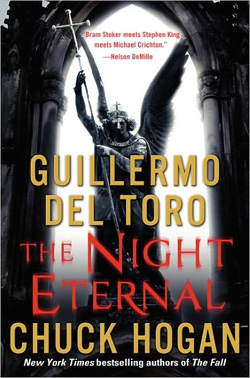The Strain, the first book in Guillermo del Toro and Chuck Hogan’s vampire trilogy, set off my skepticism triggers early. Specifically, it was the 777 jet that landed at JFK and then sat silent on the runway, with nearly all the crew and passengers dead, stymying investigators from the Center for Disease Control. “Come on,” I thought, “you’re telling me nobody in this world has read Bram Stoker?” Then there was the multi-billionaire villain named Eldritch Palmer, who’s willing to sell out humanity to the ancient vampire known as “the Master” for his own shot at eternal life. Whenever he showed up, his name was distracting, because it only makes sense as a heavy-handed Philip K. Dick reference; who names their kid Eldritch?
But I stayed with it, because del Toro and Hogan kept things moving briskly enough to overwhelm all my logical objections, and I wanted to see what was going to happen to characters like Ephraim Goodweather, the CDC scientist trying to alert the world to the crisis and save his young son from his ex-wife (one of the first humans turned), or Abraham Setrakian, the elderly vampire hunter who first confronted the Master scavenging the Nazi concentration camps. Their initial attempt to eradicate New York’s strigoi problem, at the climax of The Strain, ended badly, and things got progressively worse in The Fall, the next book in the series, which ends with total vampire victory. So where can del Toro and Hogan go from there?
The Night Eternal opens two years later, and the world is still covered in near-total darkness thanks to the nuclear winter triggered by the Master at the end of The Fall. Most of humanity’s best and brightest—”lawmakers and CEOs, tycoons and intellectuals, rebels and figures of great popular esteem”—were purged early with a brutal efficiency Pol Pot would have envied. (And the authors know it, calling the slaughter “Night Zero.”) The survivors have almost entirely acquiesced to the new status quo, including the farms where humans are bred and harvested to provide the strigoi with a steady food supply.
It’s less like the film Daybreakers than it sounds like, though; if you read DC’s Final Crisis a few years back, the Master’s New York City is similar to the grim totalitarian dystopia of Darkseid’s victory; if you haven’t, imagine Orwell’s Oceania ruled by the undead. As the last vampire not in the Master’s thrall explains, “he lived among you like a deviant sociologist, learning everything he could from and about you, in order to engineer your collapse. Patterns over time. The Master learned to align himself with influential power brokers… and corrupt them. He devised a formula for the mathematics of power. The perfect balance of vampires, cattle, and wardens.”
There is a small resistance, of course, but Ephraim’s despair over the loss of his son has left it severely fractured: Some think he’s just an alcoholic screw-up, while others believe he’s still essential to the cause. They have an ancient manuscript, the Occido Lumen, which holds the secret to destroying the Master, but only if they can interpret it in time. And, thanks to Abraham’s last protégé, the former exterminator Vasily Fet, they’ve got their hands on a nuke….
Apart from a brief recap at the beginning, del Toro and Hogan are still running at the same breakneck pace, and the action-movie plotting makes for a brisk read. Their efforts to combine a plausibly scientific-sounding explanation for vampire evolution with Biblical legends stretching back to Sodom and Gomorrah and the archangels is a bit convoluted, but it holds up internally and lends itself to some entertaining backstory passages. If you haven’t read the first two books, you can follow along with The Night Eternal at a superficial level, the same way you can watch Omen III: The Final Conflict without having seen the predecessors—but, as in that case, it’s not nearly as much fun. The trilogy’s entertainment value lies, for the most part, in its unrelenting narrative momentum; if any of its components are missing, the effect is sharply diluted. If you’ve been on board since the release of The Strain two years ago, though, chances are good you’ll be pleased with how everything (even one absurdly contrived coincidence involving a space station) leads to the mega-blowout ending of all del Toro and Hogan’s mega-blowout endings.
Ron Hogan is the founding curator of Beatrice.com, one of the first websites to focus on books and authors. Lately, he’s been reviewing science fiction and fantasy for Shelf Awareness. (Chuck Hogan is no relation.)










